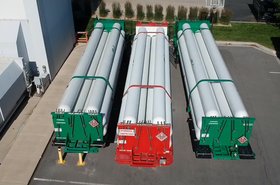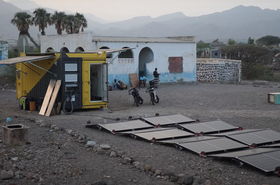Microsoft is teaming up with Caterpillar and Ballard Power Systems to test out hydrogen fuel cell backup generators at its data center in Quincy, Washington.
The three-year project to incorporate a large-format hydrogen fuel cell into a data center is supported and partially funded by the US Department of Energy (DOE) under the H2@Scale initiative and backed by the National Renewable Energy Lab (NREL).
Caterpillar will be the prime contractor on the project, providing the overall system integration, power electronics, and controls. Ballard will supply the 1.5 MW ClearGen-II hydrogen fuel cell power generator. NREL will perform analyses on safety, techno-economics, and greenhouse gas (GHG) impacts.
“This hydrogen fuel cell demonstration project enables us to collaborate with industry leaders to take a large step toward commercially viable power solutions that also support our customers in making their operations more sustainable,” said Jason Kaiser, vice president of Caterpillar Electric Power.
The project aims to provide uninterruptible power that supports 99.999 percent uptime requirements, as well as explore the feasiblity of scalability and 48-hour operation using on-site fuel.
Microsoft powered a row of data center servers for 48 consecutive hours using hydrogen fuel cells back in 2020, using a 250kW fuel cell from Power Innovations. At the time, it said it hoped to next test out 3MW hydrogen fuel cells (equivalent to its 3MW diesel generators), but appears to have first turned to these 1.5MW systems.
Speaking at DCD’s Towards Net-Zero event earlier this year, Microsoft's Mark Monroe said that early tests were simply about seeing if hydrogen fuel cells could take the place of generators. "But the real opportunity, in my opinion, is when we start getting into generation two of this and say, well, ‘What would we do differently with the electrical system in a hyperscale data center if we had reliable direct current non-polluting power available at the drop of a hat?'" he said.
“I think you’d want to start looking at different architectures and, maybe, changing the whole way the electrical system works; [examining] how it might be reworked.”
There are still challenges, however. For fuel cells to provide 3MW of power for 48 hours requires about 18,000 US gallons of liquid hydrogen, which takes up a lot more space than the equivalent diesel. Hydrogen also leaks, and requires its own supply networks, and must be kept at around -250 degrees celsius or in excess of -420 degrees Fahrenheit to stay a liquid.
“We are certainly are looking at other fuels… I expect in that 2030 timeframe there will be a number of different solutions, including other liquid fuels,” said Monroe.
Microsoft has committed to ending its dependency on using diesel fuel in back up generators by 2030, along with a broader promise to be carbon negative by that point.





